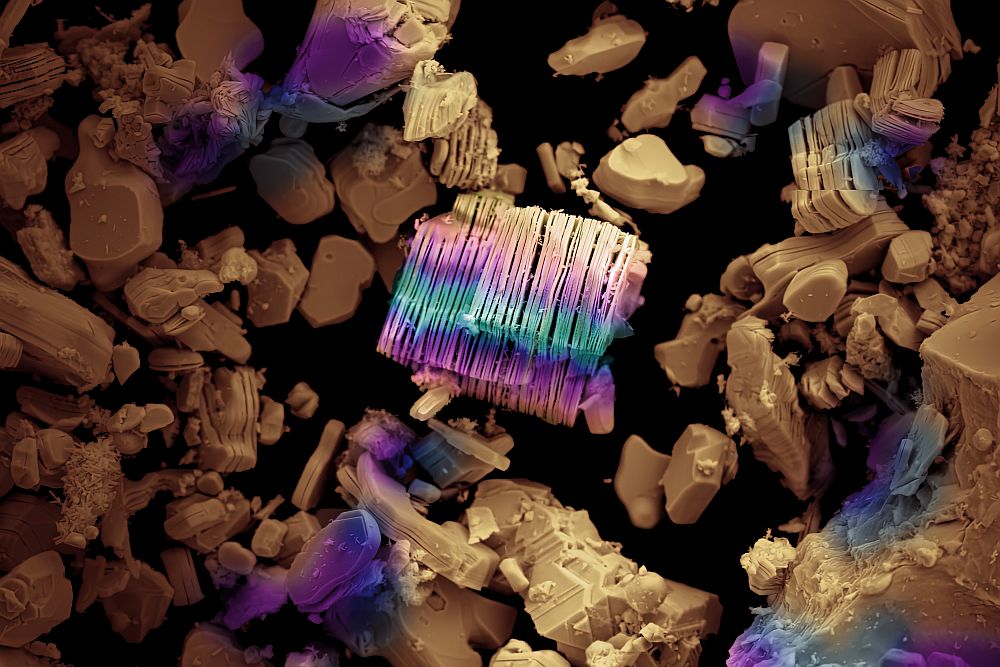
[Image above] Credit: ECO LENS, Shutterstock
The evolution of life on Earth is quite a miracle. The more we learn about the vastness of the universe, the delicate state of ecosystems on Earth, the fortuitous timing of our moon’s formation, and the complexity of biogeochemical processes that brought humans out of a primordial soup, the more impossible it seems. Yet, here we are, and it is increasingly unlikely that Earth is the only planet in the universe capable of supporting life.
Existential musing aside, I am a geologist who writes about ceramics. So, I it was a bit of a shock to hear the throwaway line in this video—which I found when researching for another CTT—that clay is the origin of life on Earth. I held on to that idea, and today’s CTT is the result.
Clay minerals can function as both a scaffold and catalyst for the concentration, polymerization, and organization of organic molecules—all key steps in the formation of the first living systems. This CTT explores clay’s role in building life’s molecular foundations, how modern research continues to uncover its ancient secrets, and what this knowledge means for the search for life beyond Earth.
The architect of prebiotic chemistry: Unique properties of clay
To understand the nature of evolution on Earth, you need some background. Ever since Darwin, evolutionary biologists have struggled to explain how the building blocks of life could have spontaneously assembled into more complex polymers, such as proteins and nucleic acids, in the vast, anoxic oceans of early Earth.
Four billion years ago, Earth was a decidedly inhospitable place. It is difficult to imagine that small, inorganic molecules would encounter one another in sufficient quantities in those great oceans to combine successfully into amino acids and nucleotides, which we now recognize as the necessary precursors of life.
Prebiotic chemistry is the study of how simple molecules could have formed the building blocks of life on Earth and, potentially, elsewhere (for example, on Mars). In 1952, chemists Stanley Miller and Robert Urey simulated the Earth’s environment 4.6 billion years ago to study the origins of life. They demonstrated that electricity could catalyze the formation of amino acids in a mixed ammonia, methane, and nitrogen atmosphere and an alkaline liquid. The Miller–Urey experiment became the foundation for this field of study.
In some of their experiments, Miller found silica in the synthesized products, but he did not pay much attention to it. A more recent study recreating the Miller–Urey experiment, however, suggested that the borosilicate glass vessel may have been a key to their successful synthesis of amino acids.
Although the Miller-Urey experiment did not directly explore the role of clay in simple molecule formation, research in the field of prebiotic chemistry has since shown that clay mineral surfaces help simple molecules combine into the more complex compounds needed for life.
As explained in this article, clay’s charged surfaces effectively captured and concentrated dilute organic molecules (amino acids, nucleotides) from the primordial soup, providing a solution to the dilution problem of how these molecules found one another. A recent study showed that the amino acid proline binds to the surfaces of the clay mineral montmorillonite by pH-dependent adsorption, which facilitates concentration.
Beyond simply concentrating molecules, the charged surfaces and inherent mineral composition of metal-ion-containing clays provide catalytic sites that significantly lower the energy barriers for crucial chemical reactions. For example, these properties help to make amino acid polymerization thermodynamically favorable in water. (Shout out to my favorite mineral, smectite.)
An iron-rich clay, greenalite, formed near sea-floor vents in the ancient oceans. The grooved surfaces on this mineral may have served as templates for the formation of RNA from early nucleotides. (RNA is a single-stranded nucleic acid that plays a crucial role in protein synthesis.) The porous nature of ceramic materials makes them ideal scaffolds for biological materials, so this finding is not surprising.
(Geologic fun fact: Greenalite is the principle mineral in banded iron formations, which no longer form on Earth because they can only form in environments that lack oxygen.)
Prebiotic chemistry gave rise to systems chemistry in the early 2000s, which focuses on the overall network of interacting molecules and on their emergent properties. This field of study is now the focus of many researchers in disparate disciplines such as organic chemistry, geochemistry, astrobiology, and materials science.
Clay’s role in building life’s molecular foundations
Clay surfaces provide a localized, semi-dehydrated environment that is crucial for removing water during polymerization. Although the spontaneous polymerization of nucleotides in water is challenging, recent research has shown that key RNA precursors can achieve high-yield polymerization under simple wet–dry cycling conditions. These wet–dry cycles, mimicking humid nights and dry days on early Earth, provide a crucial environment for RNA formation.
This work was built upon earlier findings that demonstrated how montmorillonite surfaces facilitate such polymerization. Combine this information with research on reactive peptide synthesis at the air–water interface of amino-acid-containing droplets, and you have the necessary ingredients for early life. These interfaces overcome the difficulty of forming polymers in water.
Research continues into how clay minerals might have influenced the selection of specific handedness (chirality) in organic molecules, a critical step for the emergence of life. All biological amino acids on Earth are lefthanded, and all sugars in nucleic acids are righthanded.
Steric interactions between these chiral polymers preferentially arrange them into righthanded DNA double helixes, especially when montmorillonite is the catalyst. (I’ve simplified the explanation, but the significance should be obvious.) Studies suggest that clay surfaces can preferentially adsorb or catalyze the formation of one chiral form over another. For instance, the discovery of chiral amino acids, such as isovaline, forming on clay mineral surfaces in carbonaceous chondrites further supports clay’s role in this selective process, even off Earth.
Bayesian analysis of the process of abiogenesis (the evolution of life from inorganic substances) suggests that life emerged rapidly on the early Earth. From the time Earth had cooled enough to support liquid water on its surface (which has now been pushed back to approximately 4.5 billion years ago) it was not that long, geologically speaking, until the first fossil records of stromatolites emerged (3.4 billion years ago). Life’s early emergence may provide evidence that other forms of life could be abundant in the universe if early-Earth-like conditions are common (although that is a big if).
Future implications of clay’s role in abiogenesis
Studying abiogenesis deepens our appreciation for the fundamental properties and versatility of clay minerals, as well as for the staggering odds we humans have beat to arrive here. Insights into how early life’s building blocks self-assembled and were catalyzed by clay minerals are driving innovations in fields far beyond evolutionary biology—in everything from drug delivery to environmental remediation to biomimetic sensors.
In essence, by looking back at how life began from nonliving matter, materials chemists are gaining profound insights into the fundamental principles of self-organization, catalysis, and molecular interaction that can be harnessed to engineer the next generation of advanced materials and technologies.
Author
Becky Stewart
CTT Categories
- Basic Science
- Environment


